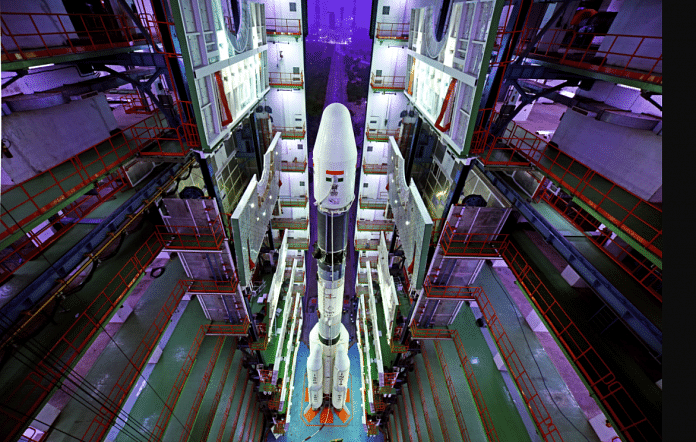The GSLV features an improved engine and the communication satellite payload will provide improved connectivity to remote areas.
Bengaluru: The Indian Space Research Organisation (ISRO) is all set to launch the high-power communication satellite, GSAT-6A, on a GSLV rocket from Andhra Pradesh’s Sriharikota at 4.56 pm Thursday.
This launch is of significance as the rocket’s cryogenic engine will be tested further and improved before the expected October launch of Chandrayaan-2, and subsequently the Mangalyaan-2.
The rocket boasts of a new Vikas 4 thruster engine, called High Thrust Vikas Engine (HTVE), which will propel its second stage. This is the twelfth flight of the GSLV and the sixth of the GSLV MkII.
The launcher
The Geosynchronous Satellite Launch Vehicle or GSLV is a 49-metre high three-stage launcher weighing 415 tonne. It is India’s heaviest and biggest rocket, capable of putting 5,000 kg into low earth orbit (up to 2,000-km high) and 2,500 kg into geosynchronous transfer orbit (35,786 km).
Its first stage has a core powered by solid propellant with the aid of four liquid propellant strap-on boosters that do not separate. The second stage is similar to that of the PSLV’s and is fuelled by liquid propellant. The third stage uses cryogenic propulsion. The payload fairing — the nose cone which ensconces the payload — sits right on top of the cryogenic upper stage (CUS).
The CUS contains two tanks — one with liquid hydrogen and other with liquid oxygen at -250 degrees and -180 degrees Celsius respectively. This stage was indigenously developed in India to replace the standard Russian design. The second stage will test the improved Vikas engine that has been in the works for three years. Five of these engines would be used in the Chandrayaan-2 launch. This is the sixth flight for the CUS engine and the first for the Vikas-4 HTVE. The development, testing, and improvement of both would be crucial to ISRO’s future planetary missions.
GSLV launches are named for their configuration — F for flight stage and D for developmental. The engine of the rocket to be launched Thursday was tested already and is ready for flight, hence the launch is called GSLV-F08.
The payload
GSAT-6A will join its twin GSAT-6 launched in 2015 as India’s two advanced S-band satellites. It weighs over 2,000 kg and carries one of India’s largest satellite antennas which will unfurl like an umbrella in orbit. The antenna’s giant size will give enough power to signals being transmitted for very tiny, handheld devices to receive them.
The satellite in conjunction with GSAT-6 will provide strong connectivity to remote places with deprived mobile networks. They will be primarily used for government and military communication. GSAT-6A will orbit at an altitude of 36,000 km.
ISRO has classified this satellite as a technology demonstrator for high power S-band two-way communication.
The flight
The rocket will launch from Sriharikota’s second launch pad at 4.56 pm. Seventeen minutes and 46 seconds into the flight, the satellite will be released at a height of 254 km and will swing around the earth in a highly elliptical orbit, reaching the farthest distance (apogee) of 35,975 km.
It will then go around the earth thrice using inbuilt propulsion in the satellite, performing orbit raising manoeuvres each time, before settling into its final orbit of 36,000 km.
The mission is expected to last at least 10 years.



